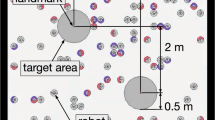Abstract
For self-assembly, robot swarms can be programmed to form predefined shapes. However, if the swarm is required to adapt the assembled shapes to dynamic features of the environment at runtime, then the shapes’ structures need to be dynamic, too. A prerequisite for adaptation is the exploration and detection of changes followed by appropriate rearrangements of the assembled structure. We study a robot swarm that forms trees to explore its environment and searches for bright areas. The tree-formation process is inspired by the vascular morphogenesis of natural plants. The detection of light produces a virtual resource shared within the tree, helping to drop useless branches while reinforcing efficient paths between the bright areas and the tree root. We successfully verify our approach with several swarm robot experiments in a dynamic environment, showing that the robot swarm can collectively discriminate between light sources at different distances and of different qualities.
Access this chapter
Tax calculation will be finalised at checkout
Purchases are for personal use only
Similar content being viewed by others
Notes
- 1.
Zenodo: https://doi.org/10.5281/zenodo.1251312.
Youtube: https://youtu.be/M0Lu97QMKWM.
References
Adamatzky, A.: Physarum Machines: Computers from Slime Mould. World Scientific (2010)
Bonifaci, V., Mehlhorn, K., Varma, G.: Physarum can compute shortest paths. J. Theor. Biol. 309, 121–133 (2012)
Deneubourg, J.L., Goss, S., Franks, N., Pasteels, J.: The blind leading the blind: modeling chemically mediated army ant raid patterns. J. Insect Behav. 2(5), 719–725 (1989)
Divband Soorati, M., Hamann, H.: Robot self-assembly as adaptive growth process: collective selection of seed position and self-organizing tree-structures. In: IEEE/RSJ International Conference on Intelligent Robots and Systems (IROS), pp. 5745–5750 (2016). https://doi.org/10.1109/IROS.2016.7759845
Dorigo, M., Maniezzo, V., Colorni, A.: Ant system: optimization by a colony of cooperating agents. Trans. Sys. Man Cyber. Part B 26(1), 29–41 (Feb 1996). https://doi.org/10.1109/3477.484436
Gauci, M., Nagpal, R., Rubenstein, M.: Programmable self-disassembly for shape formation in large-scale robot collectives. In: 13th International Symposium on Distributed Autonomous Robotic Systems (DARS) (2016)
Gebhardt, G.H., Daun, K., Schnaubelt, M., Neumann, G., et al.: Learning robust policies for object manipulation with robot swarms (2018)
Goldstein, S.C., Campbell, J.D., Mowry, T.C.: Programmable matter. Computer 38(6), 99–101 (2005)
Hamann, H.: Swarm Robotics: A Formal Approach. Springer (2018)
Hamann, H., Divband Soorati, M., Heinrich, M.K., Hofstadler, D.N., Kuksin, I., Veenstra, F., Wahby, M., Nielsen, S.A., Risi, S., Skrzypczak, T., Zahadat, P., Wojtaszek, P., Støy, K., Schmickl, T., Kernbach, S., Ayres, P.: flora robotica–an architectural system combining living natural plants and distributed robots (2017). arXiv preprint arXiv:1709.04291
Hamann, H., Wahby, M., Schmickl, T., Zahadat, P., Hofstadler, D., Støy, K., Risi, S., Faina, A., Veenstra, F., Kernbach, S., Kuksin, I., Kernbach, O., Ayres, P., Wojtaszek, P.: flora robotica—mixed societies of symbiotic robot-plant bio-hybrids. In: Proceedings of IEEE Symposium on Computational Intelligence (SSCI), pp. 1102–1109. IEEE (2015). https://doi.org/10.1109/SSCI.2015.158
LaValle, S.M., Kuffner, J.J.: Rapidly-exploring random trees: progress and prospects. In: Donald, B.R., Lynch, K.M., Rus, D. (eds.) Algorithmic and Computational Robotics: New Directions, pp. 293–308. A. K. Peters, Wellesley, MA, USA (2001)
Levi, P., Kernbach, S. (eds.): Symbiotic Multi-Robot Organisms: Reliability, Adaptability, Evolution. Springer (Feb 2010)
McEvoy, M.A., Correll, N.: Materials that couple sensing, actuation, computation, and communication. Science 347(6228) (2015). http://science.sciencemag.org/content/347/6228/1261689
Rubenstein, M., Ahler, C., Nagpal, R.: Kilobot: a low cost scalable robot system for collective behaviors, pp. 3293–3298 (2012)
Rubenstein, M., Cornejo, A., Nagpal, R.: Programmable self-assembly in a thousand-robot swarm. Science 345(6198), 795–799 (2014). https://doi.org/10.1126/science.1254295
Saldana, D., Gabrich, B., Salda, D.: Modquad: the flying modular structure that self-assembles in midair (2018)
Schmickl, T., Crailsheim, K.: A navigation algorithm for swarm robotics inspired by slime mold aggregation. In: Şahin, E., Spears, W.M., Winfield, A.F.T. (eds.) Swarm Robotics—Second SAB 2006 International Workshop, LNCS, vol. 4433, pp. 1–13. Springer, Berlin, Heidelberg, New York (2007)
Zahadat, P., Hofstadler, D.N., Schmickl, T.: Development of morphology based on resource distribution: finding the shortest path in a maze by vascular morphogenesis controller. In: 14th European Conference on Artificial Life (ECAL), vol. 14, pp. 428–429 (2017)
Zahadat, P., Hofstadler, D.N., Schmickl, T.: Vascular morphogenesis controller: a generative model for developing morphology of artificial structures. In: Proceedings of the Genetic and Evolutionary Computation Conference, pp. 163–170. GECCO’17, ACM, New York, NY, USA (2017). https://doi.org/10.1145/3071178.3071247
Author information
Authors and Affiliations
Corresponding author
Editor information
Editors and Affiliations
Rights and permissions
Copyright information
© 2019 Springer Nature Switzerland AG
About this paper
Cite this paper
Divband Soorati, M., Zahadat, P., Ghofrani, J., Hamann, H. (2019). Adaptive Path Formation in Self-Assembling Robot Swarms by Tree-Like Vascular Morphogenesis. In: Correll, N., Schwager, M., Otte, M. (eds) Distributed Autonomous Robotic Systems. Springer Proceedings in Advanced Robotics, vol 9. Springer, Cham. https://doi.org/10.1007/978-3-030-05816-6_21
Download citation
DOI: https://doi.org/10.1007/978-3-030-05816-6_21
Published:
Publisher Name: Springer, Cham
Print ISBN: 978-3-030-05815-9
Online ISBN: 978-3-030-05816-6
eBook Packages: Intelligent Technologies and RoboticsIntelligent Technologies and Robotics (R0)




